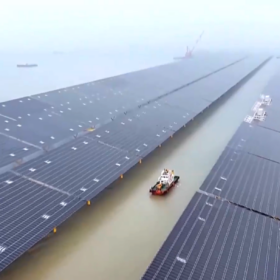CHN Energy starts connecting 1 GW of offshore solar in China
CHN Energy has connected the first phase of its 1 GW offshore solar project in China to the grid, marking progress on what it calls the world’s largest open-sea solar array, capable of powering 2.67 million urban residents upon completion.
‘Typhoon-resistant’ offshore PV project nears completion in China
China Three Gorges Corp. has nearly completed a 180 MW offshore solar plant, designed for typhoon resistance, off the coast of China.
Tata Power unit commissions 126 MW of floating solar in India
Tata Power Renewable Energy has completed a 126 MW floating PV array in Omkareshwar, India. The installation features 213,460 bifacial glass-to-glass modules.
Masdar, Sarawak Energy, Gentari plan large-scale floating solar in Malaysia
Abu Dhabi Future Energy Co. (Masdar) is teaming up with Malaysia’s Sarawak Energy and Gentari to assess the potential for a large-scale floating solar array on the northwestern coast of Borneo.
Hexa Renewables commissions world’s largest offshore floating solar plant
Hexa Renewables has completed the world’s largest offshore floating PV plant in Taiwan. The 440 MW solar array covers 347 hectares of government-leased surface area and can supply power to about 74,000 households.
TotalEnergies Eneos completes 1.8 MW floating solar array in Thailand
TotalEnergies Eneos has completed a 1.8 MW floating solar array in Thailand, featuring more than 3,000 modules to generate 2,650 MWh per year under a power purchase agreement with Thai manufacturer S. Kijchai Enterprise.
French startup unveils new floating PV tech based on aluminum
HeliosLite has developed new aluminum floaters that can be assembled and deployed at an on-site mini factory. It presented a prototype PV system based on the new floating tech this week in southern France.
Rotating, vertical floating PV system for offshore applications
An international group of scientists has designed a patented mooring tech and a vertical PV system that reportedly allows the bifacial solar panels to align with the prevailing wind direction to shed wind loads. Depending on a project’s latitude, the system can deliver different power yield.
Power-generating breakwaters for floating photovoltaics
Scientists from Singapore have designed new floating breakwaters integrating wave energy converters that can be used to reduce the impact of waves on offshore PV systems. Their analysis showed that the wave energy systems can achieve the highest additional power output when the wavelength is shorter.
New method to identify optimal floating PV sites
Researchers in Spain have created a novel method to select within a set of water bodies those where the investment in floating PV could be most beneficial. They combined geographic information systems, multi-criteria analysis, and intelligent optimization. The new approach reportedly results up to 8.4% better LCOE compared to conventional methods.










